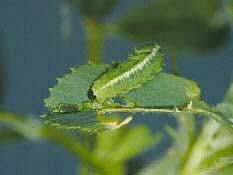
Female weevils deposit their eggs in alfalfa litter, stubble and fresh stems. The number
of eggs in a cluster ranges up to about 40 with an average of 9 or 10. The average female lays between 600 and 800.
A yellowish legless larval with a black head emerges from the egg and climbs up to feed on terminal growth.
As the larva develops, it becomes green. A full grown larva is about 3/8" long. Normally, it takes about three weeks
for the weevil to go through the larval stages. When fully grown, the larva spins a cocoon on the leaves of the alfalfa plant
or among debris on the ground. The larva pupates within this cocoon and the adult weevil emerges in about 10 days.
After feeding for a time, it flies from the field and remains inactive during the summer. The adult will return to an alfalfa
field in the fall. It will lay some eggs in the fall and most of them the following spring.
The best alfalfa weevil management decisions are based on
stem sampling procedures
. If this information is not available then control is recommended when 25% to 50% of the tips are being skeletonized and
3 or more larvae can be found per stem.
Routine stubble sprays are not justified. If early harvest was used as a weevil management tool, there occasionally
may be sufficient larvae or newly-emerged adults present to justify an insecticide application. Watch such fields carefully
for the normal green-up that indicates active regrowth. Surviving larvae may feed on developing leaves and new adults
can cause "notch-like" feeding holes on leaves giving them a feathery appearance. To protect honey bees, do not make
insecticide applications when the crop or weeds are blooming.
Your county agent can show how stem sampling based upon degreeday accumulations can help you to detect
damaging levels early.
| Insecticide | Rate per Acre | Harvest or Graze (days) |
| Ambush 2EC (permethrin) | 6.4 to 12.8 fl oz | more than 6.4 fl oz = 14 days |
| Dimethoate E267 | .75 to 1.5 pt | 10 |
| Baythroid 2 (cyfluthrin) | 1.6 to 2.8 fl oz | 7 |
| Furadan 4F (carbofuran) | 1/2 pt 1 pt 2 pt |
7 14 28 |
| Guthion 50WP (azinphos methyl) | 3/4 to 1 lb | 3/4 to 1 lb = 14; 1 lb = 16 |
| Lorsban 4E (chlorpyrifos) | 1 to 2 pts | 1 pt = 14 more than 1 pt = 21 (Some temporary yellowing may occur after application, but will disappear.) |
| Malathion 57% EC (malathion) | 1-1/2 to 2-1/4 pts | 0 |
| Mustang Max | 2.24 to 4.0 fl oz | 3 |
| Methyl Parathion 4 EC | 1/2 to 1 pt | 15 |
| Pounce 3.2 EC (permethrin) | 4 to 8 fl oz | more than 4 oz = 14 |
| Sevin 80 S (carbaryl) | 1-7/8 lbs | 7 May cause temporary bleaching of tender foliage. |
| Sniper 50 PVA (azinphos methyl) | 3/4 to 1-1/2 lbs | 1/2 to 3/4 lb = 14 1 lb = 16 more than 1 lb = 21 |
| Warrior 1 CS (lambda-cyhalothrin) | 2.56 to 3.84 fl oz | forage = 1 hay = 7 |
| #/30 stems** | 20+ | 33+ | 47+ | 60+ |
| #/30 stems* | 17-20 | 17-32 | 23-46 | 23-59 |
| Plant height | 2" | 4" | 6" | 8" or taller |
* Spray with a short residual insecticide if the number of larvae/30 stems exceeds the number in the table above for the appropriate alfalfa height
**Sample again in 2 days if the number of larvae/30 stems is in this range for the appropriate alfalfa height. If numbers are below this level, no treatment should be necessary.